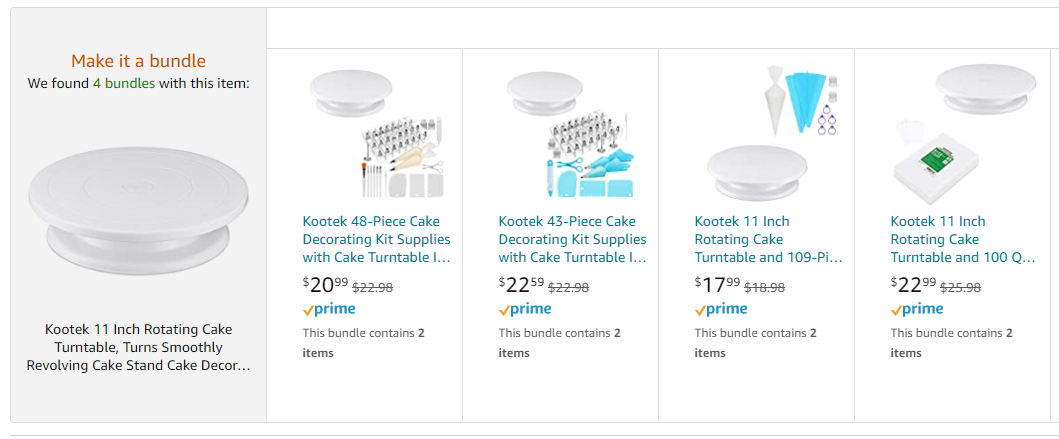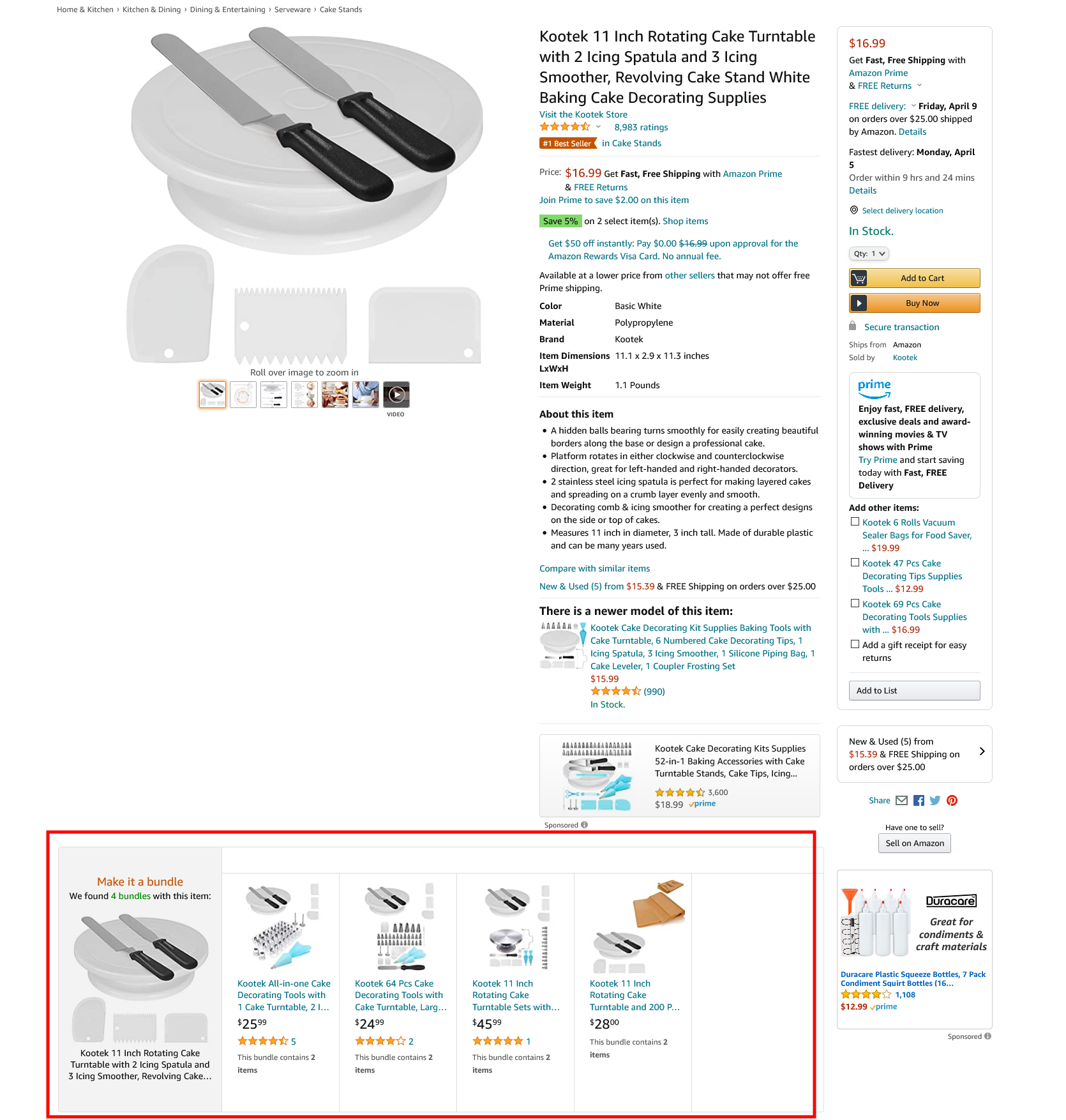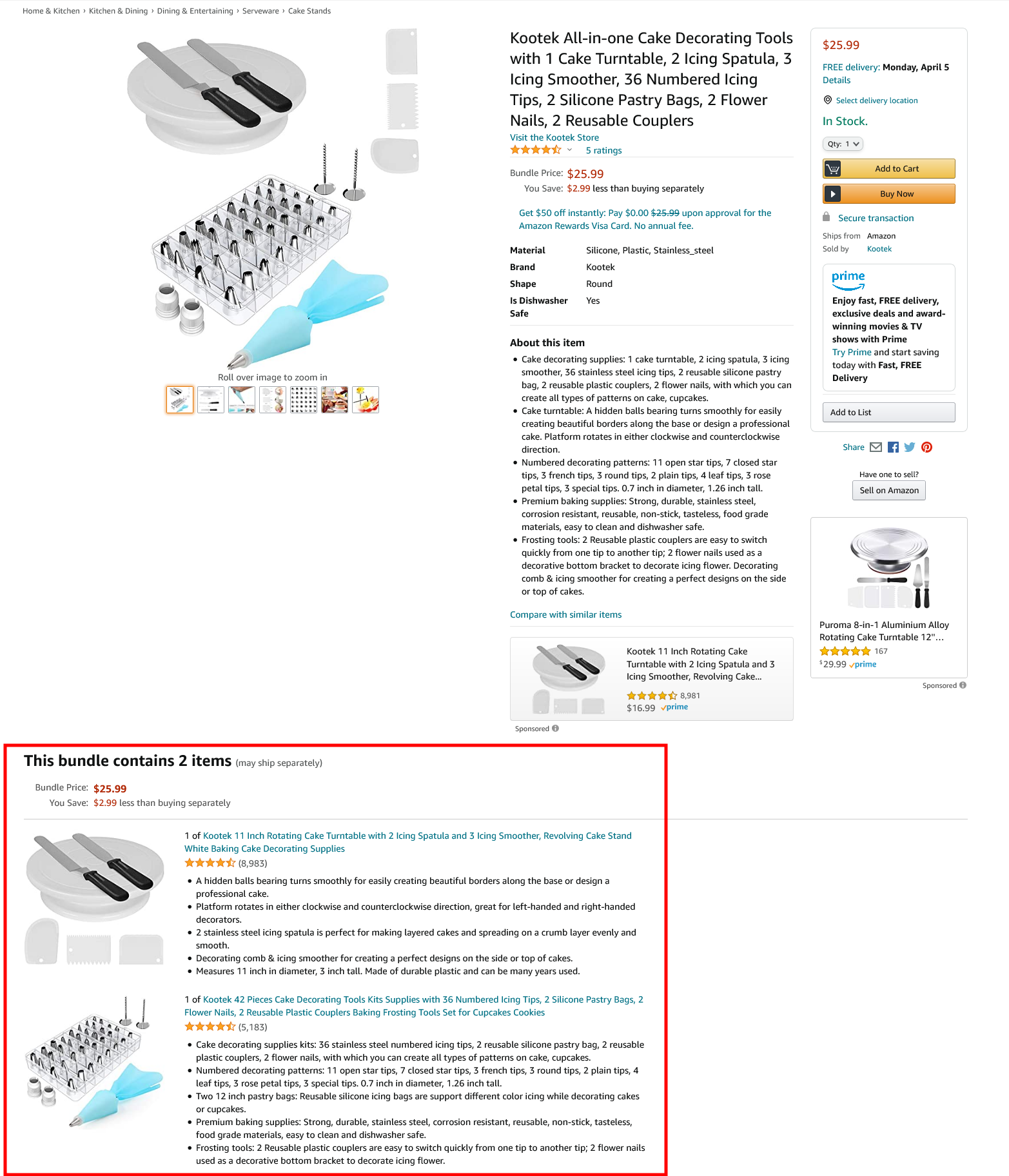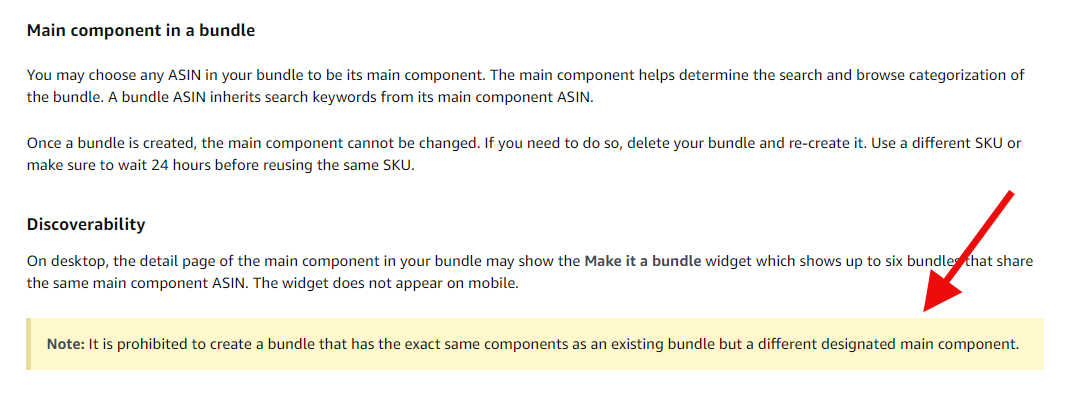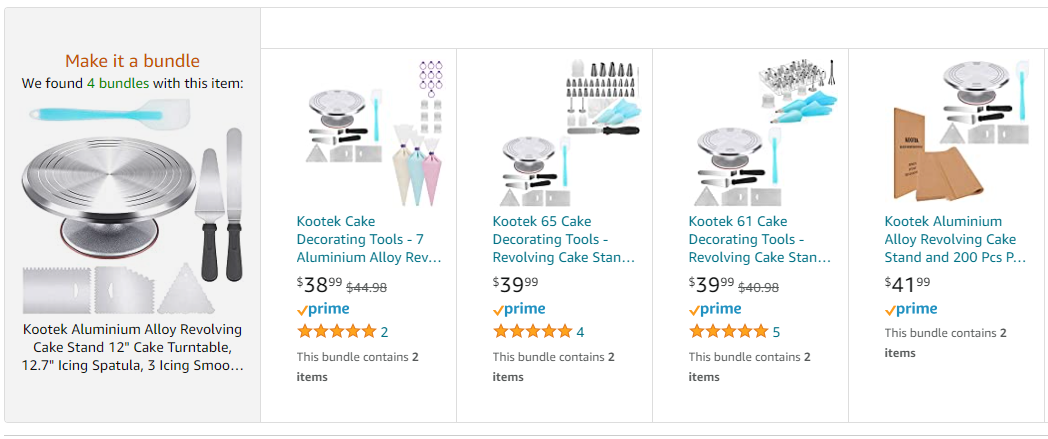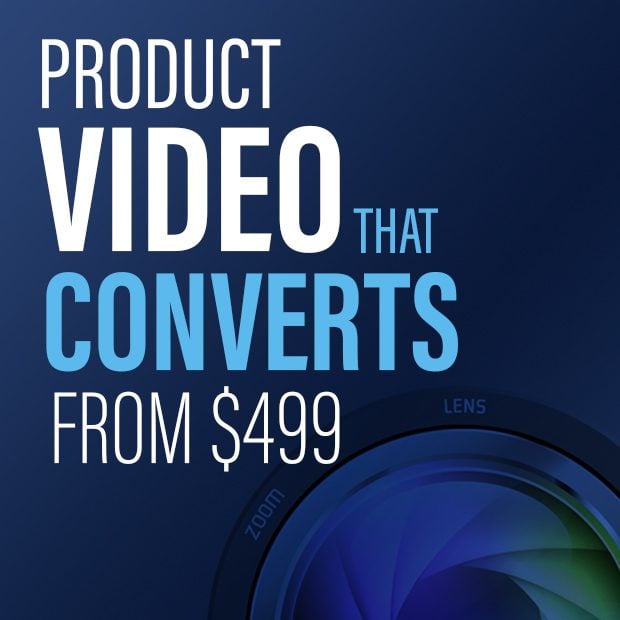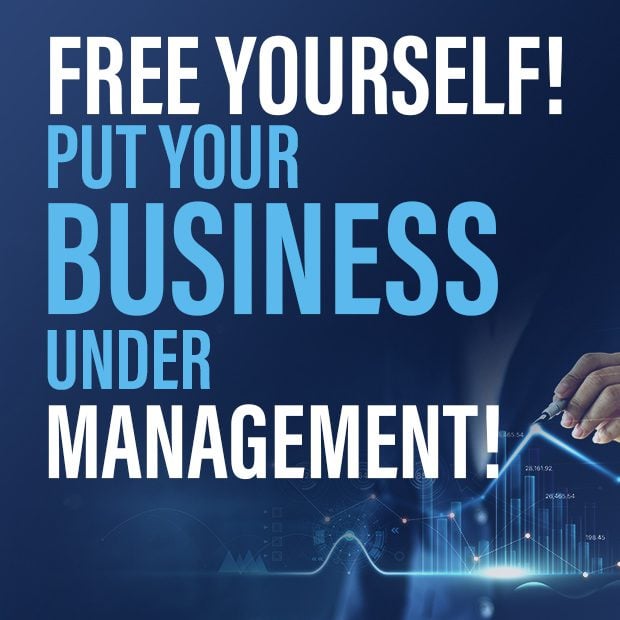Amazon Virtual Bundles: The Easy Way to Boost Revenue with Virtual Product Bundling

Have you ever thought about bundling several products that you’re selling on Amazon, but the thought of extra inventory management, higher storage fees, and the uncertain ROI has you toss those thoughts aside?
Well, if so, you’ll be pleased to know that you can now create product bundles on Amazon—virtually.
What does that mean?
Well, in late 2020, Amazon launched a feature called Amazon Virtual Bundles. The feature allows you to combine multiple products without having to physically package them together.
You create the bundle in Seller Central, then it shows up on your product page.
Here’s an example of what bundles look like on a product page:
Bundling products like this (i.e. virtually) helps save on extra inventory costs and allows you to capitalize on work you’ve already done.
For instance, take another look at the example above. The main product is a turning cake stand. You can guess that the customer will use it for a cake, but what other products relate to a cake stand?
Or another way of phrasing it: What might a person who is purchasing a cake stand need to complete their ultimate objective?
In this example, this brand used the Virtual Bundle tool to provide prospects with solutions that might save them the time they’d otherwise spend shopping around looking for each product individually.
Worth noting: This listing doesn’t just have one bundle, it has four. Each of the bundles is customized to the varying needs that each cake stand user may have.
Okay, so you understand the potential of the tool, but how do you get access to it?
Currently, Amazon Virtual Bundles are only available to sellers enrolled in Amazon’s Brand Registry program and selling on the U.S. marketplace.
If you’re not already brand-registered, you want to make sure to get that process started ASAP. Beyond Virtual Bundles, there is a lot of other impressive promotion and revenue-generating features you’ll get access to.
Now that we’ve laid the groundwork, in the remainder of this article, we’ll give you an overview of the Amazon Virtual Bundles guidelines and what you need to know to get the most out of the tool.
The Basics of Amazon Virtual Bundles
Now that you know you have the option to create virtual product bundles on Amazon, your brain might be exploring all sorts of ideas of how you can use this feature to increase revenue. Great! But, before you start brainstorming product bundle ideas, there are a few operational rules and guidelines you’ll want to know:
- Currently, you’re only allowed to bundle two to five products.
- When a customer orders one of your bundles, the order shows up in Seller Central as though they purchased each item in a single order.
- Customers can return individual products within your bundle.
- You can control the quantity of a product within a bundle. For example, if you sell a sponge and a soap individually, and now you want to bundle them together, you could create a bundle with 2 sponges and 1 soap.
- Bundled ASINs have separate reviews and ratings that don’t affect the reviews and ratings on the individual products within the bundle.
- Your bundle must have the main product that each subsequent bundle anchors off of—we’ll dive deeper into this shortly.
- The Virtual Bundles widget sits on the main product’s listing page under your product images and bullet. When a prospect clicks on any of the bundles, they’ll go to a dedicated bundle product page. Take a look at the examples below:
Here’s the Virtual Bundle Widget on the main product page:
Here’s the bundle product page we land on when we click on the first bundle in the widget:
How Pricing Your Virtual Bundles Works
Some sellers might think, “If I can create bundle products virtually, then I can charge higher prices for the same products with little effort. Traditionally, bundles equate to higher perceived value, so that means higher prices, right?”
Well, as far as Amazon is concerned, no.
The Amazon Virtual Bundles guidelines say you’re allowed to price your bundles at a price that equates to the total of each individual product combined or at a discount.
But, here’s something to consider:
You can choose to price your bundle higher than all the individual products within the bundle combined—and your bundle might still show up—but, you’ll lose the Buy Box. Which defeats the purpose of using Virtual Bundles to boost your sales, to begin with.
So, whenever you make individual product price changes—particularly a price drop, you’ll want to make sure you also update the bundle price.
How Virtual Bundles Rank in Amazon
As an Amazon seller, you understand how much product ranking can influence sales and longevity within the market. So, that begs the question: How do Virtual Bundles rank in the Amazon search engine, if at all?
Well, good news.
Virtual Bundles rank on Amazon. The way that each bundle is ranked is based on the main product component. Whatever keywords and categories your main product is associated with, that’s how your bundle will rank.
Now, it appears Amazon considered the potential ways sellers might abuse this tool because one of their guidelines prevents sellers from exploiting bundle ranking.
How so?
Amazon Virtual Bundles guidelines say you’re not allowed to create the same bundle with a different main product.
Meaning, you can’t bundle a sponge and a soap with the soap as the main product, so you can rank for those keywords, and then create the same bundle, but this time with the sponge as the main product, so you can rank for those keywords as well.
Here’s what Amazon says:
The Limitations of Amazon Virtual Bundles
Overall, the guidelines for Amazon Virtual Bundles are pretty reasonable, but there are some capabilities that the feature currently lacks that you might want to know:
- You can only bundle products that you own under a single brand — Might sound obvious to some, but it would be really neat if you could create bundles with products from another brand (maybe one that you own)
- As of now, the Virtual Bundle widget only works on a desktop.
- You cannot edit the contents of a bundle. You can only edit the title, description, bullet points, price, and images. If you need to edit the contents, you’ll have to delete the bundle, wait 24 hours (if you want to use the same bundle SKU), and create a new one.
- Currently, you can advertise your bundle with Sponsored Brands Ads, but not Sponsored Products ads.
- Beware of creating bundles with products that are already a bundle — Some people want all the bells and whistles to solve their problem or need; others just want what’s absolutely necessary. When you combine products that are already bundled it can be overwhelming and cause prospective buyers too much consideration.
Here’s an example of a bundle that has several bundled products in it:
Wrapping Up
If you have products on Amazon that compliment each other, then Amazon Virtual Bundles is a tool you’ll want to deploy. It doesn’t require you to manage extra inventory, yet it can easily boost your revenue.
As a business owner, it can be easy to overlook little leverage points, but don’t fall into that trap. The feature is relatively new, so customers haven’t developed a sort of “banner blindness” to it. Now is probably a great time to get started.
If you don’t know where to start, or what bundles would be best to create, use data from Brand Analytics and the “Frequently Bought Together” section on product pages to help you validate potential product bundle ideas.
Happy Selling,
The Page.One Team
The Last Word:
One way you might consider using Amazon Virtual Bundles is to strategically launch products that can stand alone, but also compliment the customer’s journey. When you’re a brand-registered seller, there’s plenty of data available that makes identifying potentially high-ROI product bundles, easy.
Check out the “Frequently Bought Together” widgets on product pages or review the Brand Analytics data for the top products customers tend to view on the same day they view your product and the products customers purchased after viewing your product (i.e., the Item Comparison and Alternate Purchase Behavior tool).

